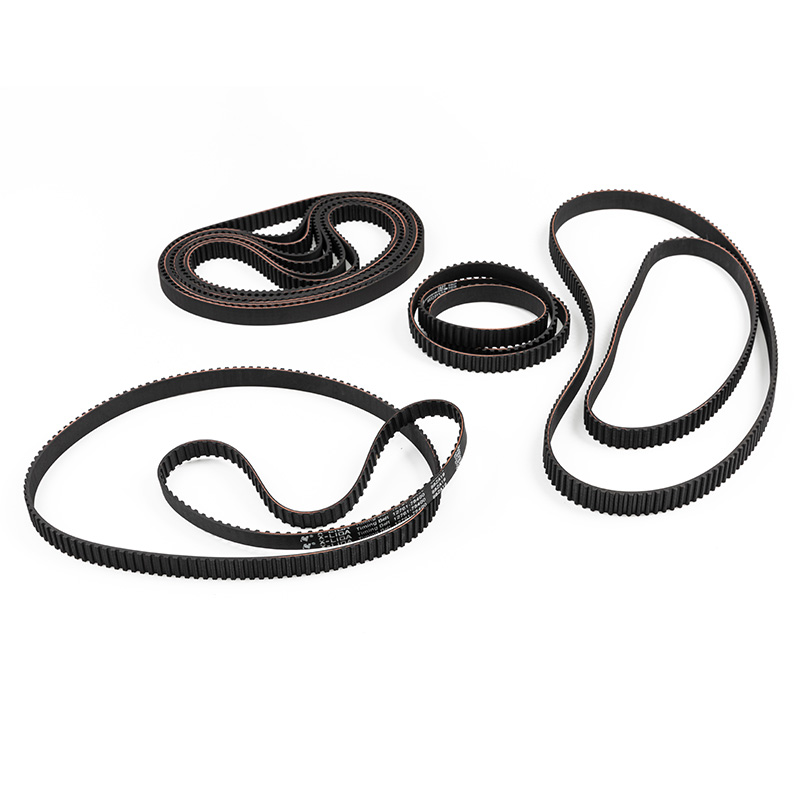Using HNBR (Hydrogenated Nitrile Butadiene Rubber) in automotive timing belts offers several advantages over other materials:
Enhanced Temperature Resistance: The hydrogenation process in HNBR rubber not only saturates the polymer chains but also introduces additional cross-linking, creating a highly stable molecular structure. This molecular arrangement enables HNBR rubber to resist thermal degradation even in environments where temperatures fluctuate dramatically, such as in high-performance engines or extreme climate conditions. Unlike conventional rubber compounds that may soften or become brittle at high temperatures, HNBR rubber maintains its mechanical properties, including tensile strength, modulus, and flexibility, ensuring reliable performance over a wide range of operating temperatures. This superior temperature resistance is critical for automotive timing belts, as they must endure the heat generated by the engine and maintain precise synchronization between the crankshaft and camshaft under varying thermal loads.
Improved Chemical Resistance: The inherent chemical resistance of HNBR rubber is a result of its tightly bound polymer chains and the presence of saturated hydrogen bonds. This molecular configuration effectively shields the rubber material from degradation caused by exposure to automotive fluids such as motor oil, gasoline, transmission fluid, and coolant. Unlike conventional nitrile rubber, which may swell, soften, or degrade when in contact with certain chemicals, HNBR rubber remains stable and inert, preserving its mechanical integrity and dimensional stability. As a result, HNBR rubber timing belts offer exceptional resistance to chemical attack and fluid absorption, ensuring long-term performance and reliability in challenging operating environments where exposure to automotive fluids is inevitable.
Extended Lifespan: The combination of superior temperature and chemical resistance, along with excellent mechanical properties, contributes to the extended lifespan of HNBR rubber timing belts. Unlike timing belts made from conventional rubber materials, which may experience accelerated degradation or wear under harsh operating conditions, HNBR rubber timing belts maintain their structural integrity and functional performance over an extended service life. This translates to fewer instances of premature belt failure, reduced maintenance requirements, and increased overall vehicle reliability. The prolonged lifespan of HNBR rubber timing belts minimizes the need for frequent replacements, resulting in cost savings for vehicle owners and operators over the long term.
Reduced Noise and Vibration: The inherent damping properties of HNBR rubber play a crucial role in attenuating noise and vibration generated within the timing belt system during engine operation. This damping effect is attributed to the viscoelastic nature of HNBR rubber, which dissipates mechanical energy and reduces the transmission of vibrations through the belt structure. As a result, vehicles equipped with HNBR rubber timing belts experience quieter operation and reduced NVH levels, enhancing driver comfort and vehicle refinement. The reduction in noise and vibration levels contributes to the overall longevity of the timing belt system by minimizing wear and fatigue on associated components, such as pulleys, tensioners, and bearings.
Enhanced Flexibility and Flex-Fatigue Resistance: HNBR rubber exhibits remarkable flexibility and resilience due to its unique molecular structure and polymer composition. The presence of hydrogenated double bonds and cross-linking within the polymer chains imparts superior flexibility to HNBR rubber, allowing the timing belt to conform to the contours of the pulleys and maintain proper tooth engagement under varying operating conditions. HNBR rubber demonstrates exceptional resistance to flex-fatigue, which is the cumulative damage caused by repeated bending or flexing of the belt during operation. This resistance to flex-fatigue ensures that HNBR rubber timing belts maintain their structural integrity and tooth profile over prolonged use, reducing the risk of premature failure due to fatigue-related issues such as cracking, delamination, or tooth wear.
Hnbr Rubber Automotive Timing Belts


 View More >>
View More >>
 View More >>
View More >>
 View More >>
View More >>
 View More >>
View More >>
 View More >>
View More >>
 View More >>
View More >>
 View More >>
View More >>
 View More >>
View More >>
 View More >>
View More >>
 View More >>
View More >>
 View More >>
View More >>
 View More >>
View More >>